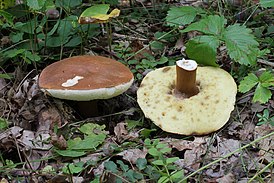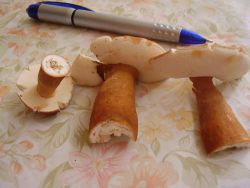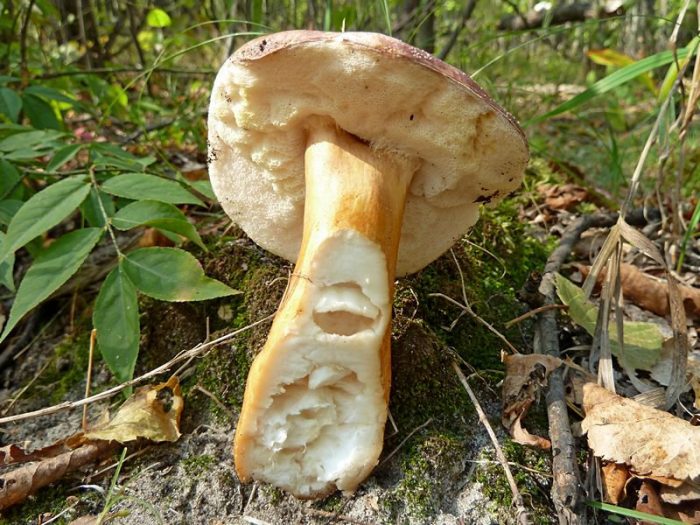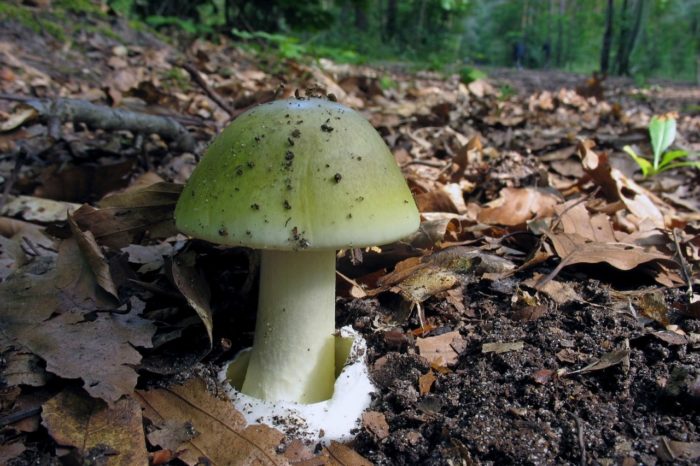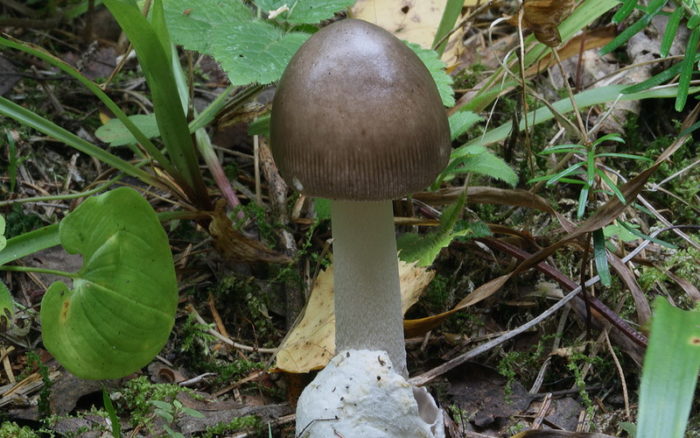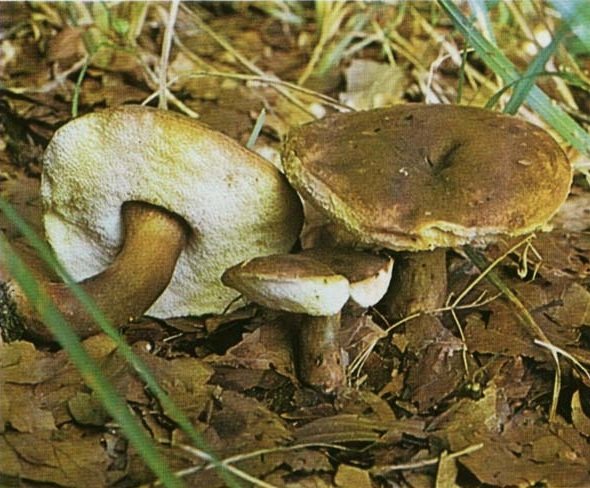Gyroporus blue (Gyroporus cyanescens)
- Other names for the mushroom:
- Blue boletus
- Bruise
Synonyms:
- Boletus cyanescens
- Boletus constrictus
- Leccinum constrictum
- Suillus cyanescens
- Suillus cyanescens
- Leucoconius cyanescens

The popular name "Bruise" accurately conveys the behavior of the fungus at the slightest damage to tissues, whether it be a cut, break or just a touch: it turns blue. The color change occurs quickly and very clearly, which makes it possible to almost accurately distinguish Blue Gyroporus from other boletus.
Description
Hat: 4-12 cm, sometimes up to 15 cm in diameter. Convex at first, then widely convex or sometimes almost flat in age. Dry, roughly rough or sometimes dull-scaly, covered with fine hairs. Straw or pale brownish, brownish yellow in color. It turns blue when touched.
Hymenophore: tubular. The surface of the pores (tubes): from white to yellowish, straw color, instantly turns blue when pressed. Contains 1-3 round pores per mm. Tubes up to 18 mm deep.

Leg: 4-12 cm long, 1-3 cm thick. More or less even or with a slight thickening in the middle part, it can taper towards the very bottom. In young specimens, it is complete, with age cavities form in the leg, in adults it is practically hollow. The leg is visually divided into two parts: at the top, directly under the cap, it is light and smooth. Below - in the color of the cap, matte, slightly pubescent. There is no ring, but the upper and lower parts of the cap are separated so sharply that you involuntarily look for where the ring is.

Flesh: white to pale yellow, brittle, brittle. It turns blue very quickly on the cut.
Smell and taste: weak mushroom, sometimes there is a pleasant, nutty taste.
Chemical reactions: ammonia negative or pale orange on the surface of the cap, negative to brownish on the flesh. KOH negative to orange on the surface of the cap, negative to brownish on the flesh. Iron salts from olive to almost black on the pulp.
Spore powder print: pale yellow.
Microscopic features: Spores of variable size, but mostly 8-11 x 4-5 µm (however, often as small as 6 x 3 µm and as large as 14 x 6.5 µm). Smooth, flowing, ellipsoidal. Yellowish in KOH.
Edibility
Blue gyroporus is suitable for human consumption. It is used dried, pickled and boiled. The data on taste are contradictory: someone thinks that it is not inferior to porcini mushroom, someone notes "very mediocre" taste.
Ecology
Various sources mention mycorrhiza with deciduous species, and different ones, such as birch, chestnut, oak. There is even an assumption about mycorrhiza with conifers, with pine. But, as noted by Singer (1945), Blue Gyroporus grows "in forests and even in meadows" and "apparently does not regularly form mycorrhiza, at least no preference for any forest tree has been proven, since sometimes fruiting bodies are formed far enough from any tree. "
Grows alone, scattered or in small groups, usually in sandy soil, especially in soil with destroyed structure (roadways, shoulders, parks, etc.)
Season and distribution
Summer and autumn. The mushroom is quite widespread in America, Europe, Russia.
Notes Considered a rare species. Blue gyroporus is listed in the Red Book of Russia.
According to some authors, Gyroporus cyanescens var. violaceotinctus differs from var. cyanescens: The flesh turns blue instantly to a rich violet-blue without going through the greenish-yellow stage. According to Bessette, Roody & Bessette (2000), a variety harvested in North Carolina does not bruise at all.
Gyroporus blue contains the pigment boletol, it is an antibiotic. It was isolated not only from the bruise, but also from some species of oak trees.
In the article and in the gallery, photos were used from the questions in recognition: Gumenyuk Vitaly and others.
False doubles
 Inedible boletus
Inedible boletus
The blue gyroporus has a slight resemblance to the inedible boletus, but that one is larger, it has yellow pores. It may taste sweet at first, but then an unpleasant bitterness is felt.
 Gall mushroom
Gall mushroom
Inexperienced fans of “quiet hunting” often confuse gyroporus with porcini mushroom. At first glance, it can be easily mistaken for a gall mushroom (inedible white). It is not poisonous, but with any processing the bitterness does not disappear, therefore it is not suitable for food.
The main difference between gyroporus and all other mushrooms is blue discoloration when pressed. No other double takes on this color.
(gyroporus)
✎ Affiliation and generic features
Gyropor or gyroporus (lat.Gyroporus) is a genus of mushrooms of the gyroporic family (lat.Gyroporaceae) and a large order of boletus (lat.boletales).
The family of gyropores (lat.Gyroporaceae) is monotypic (a group containing one directly subordinate taxon) and contains a single genus Gyroporus, which, according to recent studies (from 2008), collects only a dozen species in all.
The genus of gyropores is a very narrow genus of fungi and unites no more than 10 species that live in the temperate zone of the Northern Hemisphere, sometimes in the tropics.
On the territory of Russia, only 3 of them are considered the most famous, and these are:
- chestnut gyropore (chestnut, chestnut mushroom);
- birch gyropore (subdubovik, ink mushroom);
-
sandy gyropore (sandstone, sand mushroom)
,
and only the first 2 are significant for mushroom pickers, since the third species is toxic, weakly poisonous, although until recently it was a common variety of edible chestnut gyropore (lat.Gyroporus castaneus).
Gyropores are extremely rare edible (like chestnut gyropore) and conditionally edible (like birch gyropore) species included in the Red Book of Russia, forming mycorrhiza with very many broad-leaved species (oaks, beech trees, ash trees, elms, maples, linden trees, chestnuts), and sometimes with conifers (pines).
✎ Similar appearance and nutritional value
Gyropores, in addition to being similar to some edible mushrooms, can also resemble inedible ones.
Gyropors have such a double, and this is a gall mushroom from the genus Tolopil (tolopilus), with which they are united by the bitter taste of pulp, but distinguishes between a hollow, or with voids inside, a leg, as well as a pulp that turns blue at a break.
At the same time, it should be noted that gyropores have no similarities with poisonous species.
In terms of nutritional quality and nutritional value, gyropore mushrooms are edible, or conditionally edible, mushrooms of the second category.
Gyropores, due to their rare prevalence, are recognized as very desirable, and in the gastronomic plan - delicious mushrooms.
So, any mushroom picker will be happy to find them, and any culinary specialist (with caution, but with pleasure) will prepare an obvious masterpiece from them. But it is worth considering that gyropores are listed in the Red Book of Russia and their collection is pure poaching.
✎ Distribution in nature and seasonality
Gyropores usually prefer mixed broad-leaved or pine-oak forests, and they always choose not dense, lighted and dry areas. At the same time, they do not like to climb deep into the forest, but settle along the forest edges.
Most likely, gyropores are widespread in Western and Eastern Europe, very rich in broad-leaved trees and are found mainly in the southern regions from France to the Far East, but everywhere they are extremely rare.
On the territory of Russia, gyropore fungi are found even less often (in the temperate zone), where there are broad-leaved forests. And these are the western, southwestern outskirts of the country, the south of the European part, the Caucasus, partly Western Siberia and the Far East.
Gyropores do not bear fruit for a long time, usually from late July - early August to mid or late September.
✎ Brief description and application
Gyropores are common representatives of the section of tubular fungi and the inner zone of their cap has a porous structure.The tubules of the hymenophore (spore-bearing layer) of the gyropores are pale yellowish or coral-chalk in color. The caps of young fruits are very dense and fleshy, colored from light chestnut and orange-brown to reddish-brown, noticeably dry and velvety, or smooth to the touch. Legs without a mesh pattern, loose, in ripe fruits with voids inside or hollow. The flesh in the cap is dense, elastic, loose in the stem, white in color, and on the cut at the birch (blue) gyropore it sharply changes color, and does not change the chestnut color in the chestnut gyropore.
Different gyropore mushrooms are also cooked in different ways. Some of them (chestnut mushrooms), when boiled, are slightly bitter and therefore they are usually dried or fried raw, but not salted or pickled, because their brine tastes bitter and spoils the dish.
Others (podduboviki) can be used "raw", without prior boiling, in frying, salting, pickling, drying or in the preparation of mushroom sauces.
False doubles
The chestnut mushroom bears no resemblance to its poisonous "congeners", but it is similar to some inedible ones. Gall mushroom can confuse lovers of quiet hunting. Outwardly, it looks like chestnut, it is not poisonous, but it has a bitter taste.
The gall fungus belongs to the Tilopilov family and the Boletov family. It bears fruit in the same period as the chestnut tree. Occurs on sandy soils, mixed and coniferous forests.
 Gall mushroom
Gall mushroom
The average size of the cap is about 12 cm, the shape is convex. Coloring - in brown, brown tones. The mushroom has a white flesh, soft to the touch, grows up to 10 cm. Unlike chestnut, the cut changes color, becoming pink.
The leg reaches 3.5 cm in diameter and is dotted with a mesh pattern. Its color is beige, different from the chestnut tree. The aroma is weak, the taste of the gall mushroom is more bitter than that of the chestnut one. It can be cooked, but it is very difficult to kill the bitter aftertaste, even if soaked in salt water.
Blue gyroporus is another species that bears a resemblance to chestnut. The mushroom is also edible and rare, prefers to grow in bright places, on the edges, in the same place as chestnut. The hat is velvety and yellow-brown, the leg is white.
 Gyroporus blue
Gyroporus blue
When fractured or cut, the damaged part becomes blue, purple shades are less common.
Sometimes the chestnut mushroom is confused with the satanic one. Eating this species in significant quantities and without proper processing can cause serious health problems. In many countries, it is approved for collection and consumption. The main difference from other similar species, in particular from chestnut, is the reddish leg. Dense, white flesh turns blue on the cut.
Taste, medicinal properties, benefits and possible harm
The bruise has a pleasant nutty flavor. When fresh, it does not have a strong mushroom smell, only a light aroma. It is used boiled or fried. Suitable for preparing blanks for the winter, as it behaves well when drying and pickling. Bruise caviar has excellent taste. In addition, it is successfully used in sauces.
Many mushrooms are very valuable for medicine. Scientists create drugs from their disputes, on the basis of which remedies are made for various ailments.
Gyroporus is rich in a pigment substance - pain reliever, which can be used as an antibiotic. It is very beneficial for vegetarians, fasting people, because it contains a huge amount of protein.
Gyroporus chestnut
Another representative of the gyroporus family. Belongs to the department of basidiomycetes, forged agaricomycetes. Genus: gyroporus.
Hat
The cap of this mushroom has a characteristic rusty hue with brown spots. Less often it is red-brown. Even less often chestnut shade. The younger the mushroom, the lighter its cap, but with age it becomes darker. The diameter of the mushroom reaches 11 cm. The surface of this mushroom, if you run your hand over it, is quite velvety. Also a little fluffy. Less often, it is naked and without a single villi. If the sun's rays hit directly on the cap of the mushroom, it begins to crack.If you look under the cap, then the tubes inside are first white, then they acquire a yellow tint. As for the older age, the cap becomes less elastic and drier.

Pulp
Special attention is paid to the pulp. It is quite white, and at the same time tries not to change its color at the cut
At first, it is quite hard, while fleshy. However, it becomes more fragile with age. At the same time, her smell and taste are quite unpleasant, so many people prefer to bypass the chestnut side of gyroporus.
Leg
The leg is quite stable. It is unevenly cylindrical, but at the same time, it can bend at any angle. Clavate and fairly flattened. Dry, up to 30 mm in height. The thickness is the same. Inside, the leg is quite elastic, but with age, this elasticity is commensurately lost. Often, the cap outweighs the leg and breaks it off.
Where to grow and when to go
If you are looking to find Chestnut Gyroporus, you are very lucky. This mushroom is especially widespread in the central territory of Russia. It grows immediately as a large brood, therefore, having spotted it in a clearing, know that there are probably many of its fellows around.
This mushroom grows from July to right until November, but on condition that the autumn is warm. If it is cold, then you need to go for the mushroom at the end of September and beginning of October.
Prefers coniferous and deciduous forests for growth. Also, predominantly prefers sandy soils, cut wet. Loves dry soils, settles away from swamps.
Fruiting bodies are somewhat widespread from each other, however, they are nevertheless grouped well. In one glade, you can find up to thirty mushrooms at a time.
Edible Gyroporus chestnut
Many people say that chestnut gyroporus is much worse in its taste characteristics, in contrast to blue gyroporus. This is indeed the case. Despite the fact that this mushroom is edible, it still has a very specific taste.

First, you smell the mushrooms, and then it takes on a bitter tint. Even after heat treatment, this mushroom cannot be eaten. At some point, it becomes so bitter that there is nothing to do but throw it away. Also, he can impregnate absolutely all the ingredients that were prepared with him with bitterness. For example, if gyroporus is mistakenly baked with potatoes, the potatoes will also become very bitter.
Therefore, it is predominantly better to use such a mushroom as a seasoning. Indeed, a slight bitterness will not hurt some people, and in general, this mushroom perfectly replaces pepper, it becomes more aromatic.
To prepare the seasoning, you must perform a number of the following actions.
To begin with, the mushroom is washed well under running water.
All trash is removed. The mushroom is dried well and cut into several pieces. Then boil in boiling water for about 10 minutes. The mushroom is salted again and then carefully placed on baking paper on a baking sheet. The temperature in the oven is set at 60 to 70 degrees. Mushrooms go there for one and a half to two hours.
However, check readiness periodically. To do this, you need to take a piece of the mushroom in your hands and try to break it. As soon as this happens with a crunch, it means that the drying cycle is over. Now you need to let the mushrooms cool down at room temperature. However, try not to get wet around. Once the mushroom has cooled down, we suggest grinding it in a coffee grinder. Done, delicious and bitter seasoning will decorate any of your dishes.
Poisonous and inedible mushrooms
Kele's Dubovik (Boletus queletii)
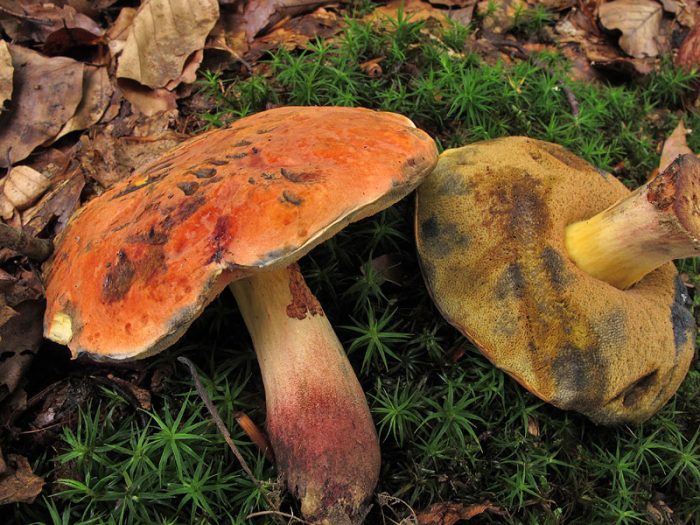
Poisonous mushroom.
The hat is up to 15 cm in diameter, round or convex. The surface is chestnut brown, velvety in young mushrooms, in mature mushrooms it becomes smooth, dry, the skin does not peel off. The flesh is fleshy, dense, yellowish, brown in the stem, turns blue on the cut. The leg is 4-15 cm high, 1-3.5 cm thick, cylindrical, thickened towards the base, solid. There are no patterns and scales on the surface, the color is yellow-brown.
A rare species that grows in deciduous forests of Russia, the Caucasus, the Far East. Fruiting season May-October
Satanic mushroom (Boletus satanas)

Poisonous mushroom.
The diameter of the cap is 8-25 cm, the shape is hemispherical, rounded-cushion-shaped, in mature mushrooms it becomes widespread, the surface is smooth or velvety, dry, painted in white, grayish, green-gray, rarely with a yellow tint. The pulp is white or yellowish, red in the stem, slightly blue or reddish on the cut, reddish in the stem. Mature mushrooms have an unpleasant odor. The leg is 5-15 cm in height and 3-10 cm in thickness, in young mushrooms, ovoid or spherical, later becomes tuberous, barrel-shaped or turnip, tapers upwards, dense, painted yellowish-red on top, bright red in the middle, brownish yellow at the base. Covered with a mesh pattern.
Grows in deciduous forests, under oaks, beeches, hornbeams, hazel, chestnuts, lindens, on calcareous soils. Found in southern Europe, Russia, the Caucasus, the Middle East, Primorsky Territory. The growing season lasts from June to September.
Red Book
Are you here:
Home - Red Data Book of Krasnodar Region - Plants listed in the Red Data Book of Krasnodar Region - Blue Gyropor Red Data Book of Krasnodar Region
Gyropor blue Red Book of Krasnodar Territory

Blue gyroporus - Gyroporus cyanescens (Bull .: Fr. 1821) Quel. 1886
Family Gyrodontaceae - Gyrodontaceae
Category and status. 3 "Rare" - 3, RD. A species with a vast range, within which it occurs sporadically.
Category according to the criteria of the IUCN Red List
Regional populations are classified as Near Threatened, NT; A. E. Kovalenko, A. A. Sopina (Kiyashko).
Not belong.
Brief morphological characteristics
A mushroom with large tubular fruiting bodies that develop on the soil. The cap is 8–12 cm in diameter, hemispherical, then cushion-shaped, dry, felt-velvety, yellow-buffy. The tubules are white, yellowing with age. The pores are small, the same color as the tubes.
Leg 5-10? 2-3 cm, cylindrical or slightly swollen in the middle part, one-color with a cap, fine pubescent in the upper part, fibrous or felt-velvety below the annular zone, has voids inside. The flesh is white, turns blue quickly and intensely in the cut. Disputes 9-11? 4.5–6 µm, ellipsoidal, smooth, pale straw yellow.
Spreading
Common area: Europe (Western and Eastern); Caucasus (North-West, Central); Ural; northern India; North Africa ; North America .
Russia: European part (Leningrad, Yaroslavl, Moscow, Tver, Belgorod, Voronezh, Penza regions); North Caucasus (KK; RA; KBR; KChR; North Ossetia - Alania; Chechen Republic); Ural (Perm region); Western Siberia (Krasnoyarsk Territory); Far East (Maritime Territory).
Krasnodar Territory: Western Caucasus: Adagum-Pshishsky district (environs of the town of Goryachy Klyuch); Belo-Labinsky district (upper reaches of the Malaya Laba river, environs of the Umpyr cordon).
Features of biology, ecology and phytocenology
Symbiotroph, forms mycorrhiza with various broad-leaved and coniferous tree species. In KK, it occurs in fir, beech-fir and oak forests from July to September. In other parts of the range, it lives in various deciduous and coniferous forests, mainly on acidic soils.
Population and its trends
The populations are characterized by low numbers; under optimal conditions, the species can sometimes reach a high number.
Security measures
It was included in the Red Book of the RSFSR (status 3R). It is necessary to control the state of the population, protect known and identify new habitats, study the biology and ecology of the species.
Sources of information. 1. Courtesuisse, Duhem, 1995; 2. The Red Book ... 2000; 3. Lazareva, 1998; 4. Red Book ... 1998; 5. Kurochkin, 1993; 6. Bedenko, 1979; 7. Rtishcheva, 1991; 8. Ivanov, 1988; 9. Kovalenko, 1980; 10. Vasiliev, 1939; 11. Sopina, 2001; 12.Shkhagapsoev, Krapivina, 2004; 13. Kalamees, Botashev, 2000; 14. Nikolaev, 2001; 15. Perevedentseva, 1996; 16. Lapitskaya, 1990; 17. Vasilieva, 1973; 18. Watling, Gregory, 1980; 19. Lincoff, 1997. Compiled by A. E. Kovalenko, A. A. Sopina (Kiyashko); rice. S. A. Litvinskaya.
|
28.10.2015 20:32:56
Back forward
-
Menu
- home
- Photo gallery
-
Animals
- Mammals
- Birds
- Fishes
- Amphibians
- Reptiles
- Insects
- Crustaceans
- Worms
- Molluscs
-
Plants
- Angiosperms
- Gymnosperms
- Ferns
- Mosses
- Seaweed
- Lichens
- Mushrooms
- Moscow
-
Moscow region
- Mammals
- Birds
- Invertebrates
- Pisces, presm., Terrestrial.
- Plants
- Mushrooms, mosses, lichens
-
Voronezh region
- Plants
- Animals
-
Republic of Crimea
- Plants
- Animals
-
Rostov region
- Plants
- Animals
-
Krasnodar Territory
- Plants
- Animals
-
Leningrad region
- Plants
- Animals
-
Pskov region
- Plants
- Animals
-
Sverdlovsk region
- Plants
- Animals
-
Saratov region
- Mushrooms
- Bryophytes
- Ferns
- Amur region
- Krasnoyarsk Territory
- Belgorod region
-
Chelyabinsk region
- Plants
- Animals
-
IUCN Red List
- Extinct mammals
- Rare birds of the world
- Cetaceans
- Carnivores
- Reserves of Russia
- Wild animals
- Birds of Russia
- Download the Red Book
- Basic documents
- Custom sog.
- .
Description and photo of Gyroporus
Gyroporus is by no means a finicky mushroom. He is used to settling in the European part of Russia. Also, he does not particularly need moisture, loves the sun and is not afraid of it. Gyroporus hats are susceptible to cracking when exposed to high temperatures when exposed to sunlight, but they still retain their appearance.
Gyroporus is very fond of forest dwellers, insects, and also, for some reason, deer prefer. It is believed that this mushroom contains substances that increase the amount of useful vitamins, have a beneficial effect on immunity and the functioning of the gastrointestinal tract.
Gyroporus is an excellent antioxidant and has long been used in folk medicine for the treatment of various kinds of diseases.
There are several types of gyroporus. Despite the fact that this is the name of one class of mushrooms, nevertheless, these species are so different that sometimes, one may wonder how they were generally attributed to the same subspecies.
Many people mistakenly believe that since gyroporus was in their hands, it means that it can be easily eaten. But actually it is not.
Some types of gyroporus are somewhat dangerous, and, unfortunately, can cause irreparable harm to health. In order to learn how to distinguish all these species from each other, we strongly recommend that you familiarize yourself with the information below. She will help you figure out how to protect yourself and your loved ones from dangerous mushrooms.
Gyroporus belongs to the genus of tubular fungi. Belong to the bolt family. They have a very smooth cap, and sometimes it is somewhat fibrous and soft.
The very pulp of this species is white, and can also change color depending on the color of the cut. The leg has no mesh pattern and is quite spongy. Many mature mushrooms have voids, or the stem is completely hollow. In a young mushroom, the tubes first have a yellow tint, and then turn white. Spore powder in these mushrooms is yellowish.
Gyroporus is far from the only one of its kind. There are three common types of it, which are found here and there.
We invite you to get acquainted with a separate subspecies in order to understand what these mushrooms are remarkable for, as well as whether or not you should collect them during the next quiet hunt.
Time and place of fruiting
Can bear fruit alone or in groups. Prefers sandy soil and light areas for growth. In a dense forest, where the sun's rays do not fall, chestnut trees cannot be found. The first mushrooms begin to appear in July, their active growth occurs in August. This species has the right to be called autumn, since it bears fruit well until the first frosts.
The fungus is widespread but rare. The decline in its number is affected by the disturbance of natural habitats due to deforestation and trampling. The quiet hunt for this species does not pass without a trace.
In Russia, it is usually found in the south of the European part, in the Caucasus, in Western Siberia and in the Far East. In the Ryazan region, it grows in the Spassky and Kasimovsky districts, in particular, near the villages of Aleshino and Samylovo.
Description of the mushroom
Chestnut is a tubular, cap mushroom. Belongs to the Boletov family, the Gyroporus genus. Sizes are larger than average.
It is called chestnut because it prefers to grow near broad-leaved trees, which include chestnut, beech and oak, and also has a color similar to the color of these trees. The name "hare mushroom" stuck because of the love of these animals to taste it.
Often the chestnut grows in symbiosis with trees, but it can do without them.
Hat
It has a convex shape, it can have various shades of brown, go into red or light brown. Velvety, dry or smooth to the touch. Older specimens have fewer villi on the cap than young ones. It can become covered with cracks - it directly depends on the weather conditions. The edges of the cap are folded upward, revealing a hymenophore of this type.
Hymenophore
The tubules at the bottom are white, yellowish or cream-colored. A yellow tint indicates that the chestnut is ripe. If you press, the color will change to dark brown. Over time, the tubular layer becomes loose and easily lags behind the stem. The tubules contain light yellow small round spores.
Pulp
The chestnut tree has a fleshy white flesh that later darkens. When broken, the color does not change. In ripe mushrooms, it is more fragile, in old ones it is hard and dry.
Leg
It has a cylindrical shape, slightly thickens towards the bottom. Its length can be no more than 8 cm, and the color is similar to the color of the cap. Slightly flattened on the sides. The leg changes with the age of the mushroom: at first it looks like cotton, and by old age it becomes empty inside.
The leg of this species has a peculiarity - having cut off the mushroom, it is impossible to see the darkening characteristic of many other representatives of the mushroom kingdom on it. The cut remains the same color.
Mushroom species
Gyroporus blue (Gyroporus cyanescens)
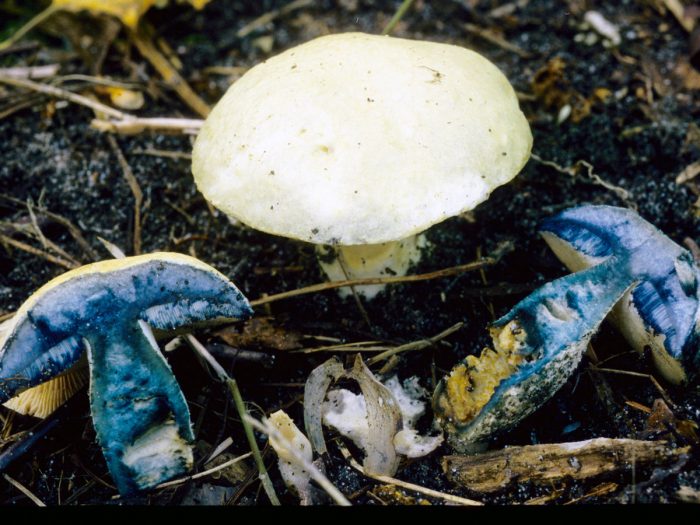
The diameter of the mushroom cap is 5-15 cm, the shape is from convex to flat, the color is straw-yellow, brown-yellow or grayish-brown, turns blue when touched. The surface of the cap is matte, velvety, dry to the touch. The flesh is brittle, white or creamy in color, it becomes bright cornflower blue when cut. It has a pleasant taste and aroma. The leg is 5-10 cm long, 1.5-3 cm thick, thickens towards the base, inside young mushrooms it is filled with cotton wool, later becomes hollow or with voids, the color is white or matches the color of the cap.
Grows in deciduous and mixed forests, often next to birches, chestnuts and oaks, on sandy soils. The fungus is found in the northern temperate zone. It is included in the Red Book of Russia as a rare species. The fruiting season is July-September.
Edible mushroom, without a bitter aftertaste, unlike chestnut gyroporus. It is often used for drying and making sauces.
Olive brown oak (Boletus luridus)

The hat is 5-20 cm in diameter, hemispherical or convex, with age it can open up to flat. The surface is olive brown, velvety, becomes slimy in wet weather. When touched, it becomes covered with dark spots. The pulp is yellowish, dense, red at the base of the stem, at the break it acquires a characteristic blue color, later becomes brown. Has a mild taste, the smell is not pronounced. The leg is 6-15 cm high, 3-6 cm thick, club-shaped with a tuberous thickening, yellow-orange in color, red-brown at the base, covered with a convex brownish-red mesh pattern with long loops.
It grows next to oaks, beeches, birches, on calcareous soils, in light, warm places, both in deciduous and mixed forests.It is a thermophilic mushroom that grows in Europe, the Caucasus, Western Siberia, and the Far East. The growing season lasts from July to September, with mass fruiting in August.
A conditionally edible mushroom that requires preliminary heat treatment (it is boiled and drained). Used in food pickled. After adding citric acid, the bluish pulp of the oak tree again acquires a yellowish color. The mushroom is also dried.
An uncooked or undercooked mushroom causes gastrointestinal upset. It is not recommended to be consumed with alcohol.
Speckled oak (Boletus erythropus)

The cap is 5-20 cm in diameter, hemispherical, cushion-shaped, rounded-cushion-shaped, the surface is velvety, dull, sometimes slimy, becomes naked as the fungus matures. The color of the cap is varied, from chestnut brown, dark brown, dark brown, black brown to olive or reddish, darkens when touched. The pulp is yellowish or bright yellow, turns blue or blue-green at the break, reddish or brownish in the stem. The taste and smell are not expressed. The leg is 5-15 cm long, 1.5-4 cm thick, cylindrical or tuberous, sometimes barrel-shaped, thickened downwards in mature mushrooms, the surface is yellow-red, without a mesh pattern, covered with red scales.
It grows in deciduous and coniferous forests, under beech, oak, spruce, fir, on acidic soils, found in swampy areas, in mosses. The species grows in Europe, the Caucasus, Siberia, and the Far East. Fruiting from mid-May to October, occurs en masse in July.
Conditionally edible mushroom, used in cooking only after boiling for 15 minutes, also used for drying. Sauces and garnishes for meat dishes are prepared on the basis of the mushroom.












